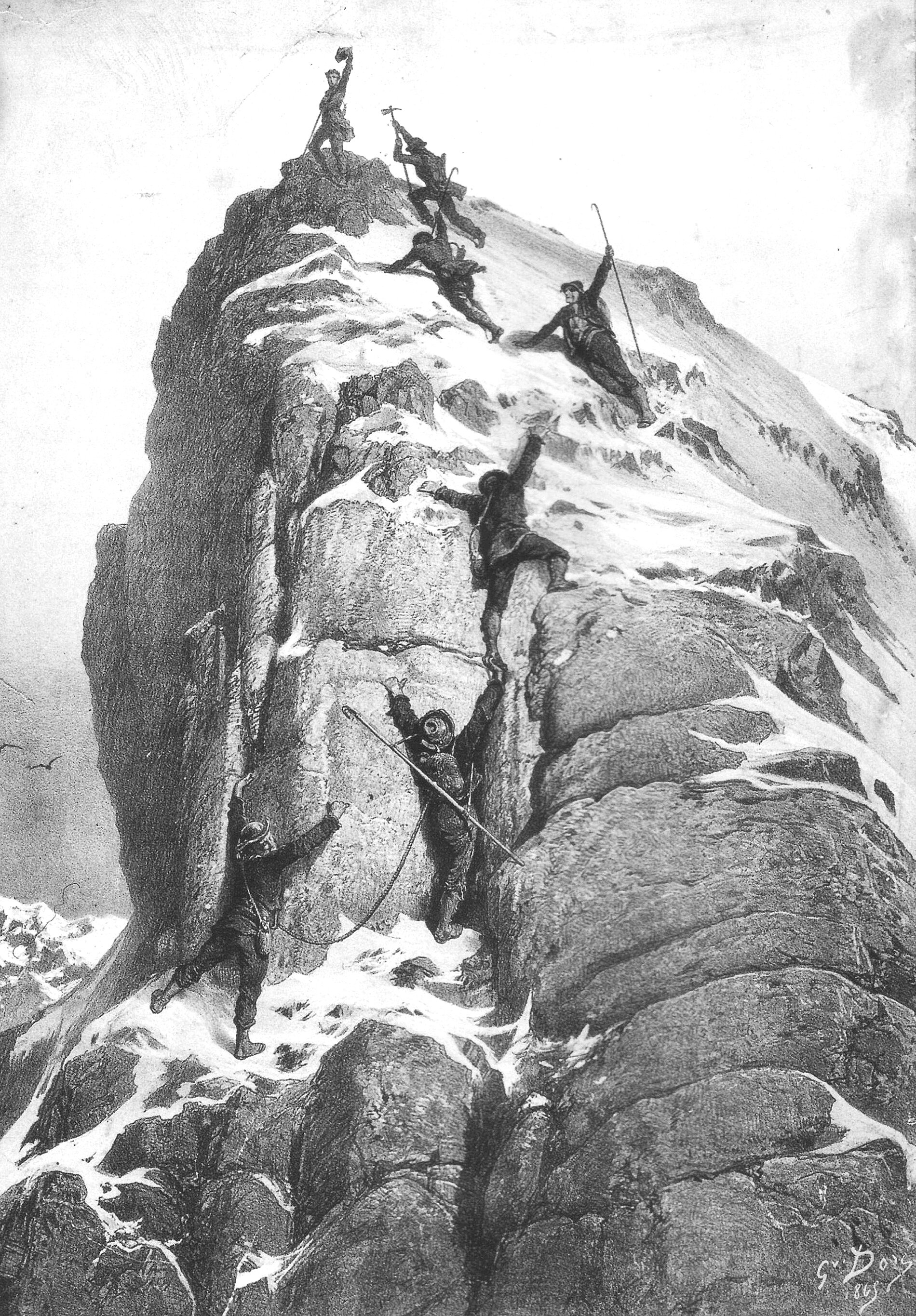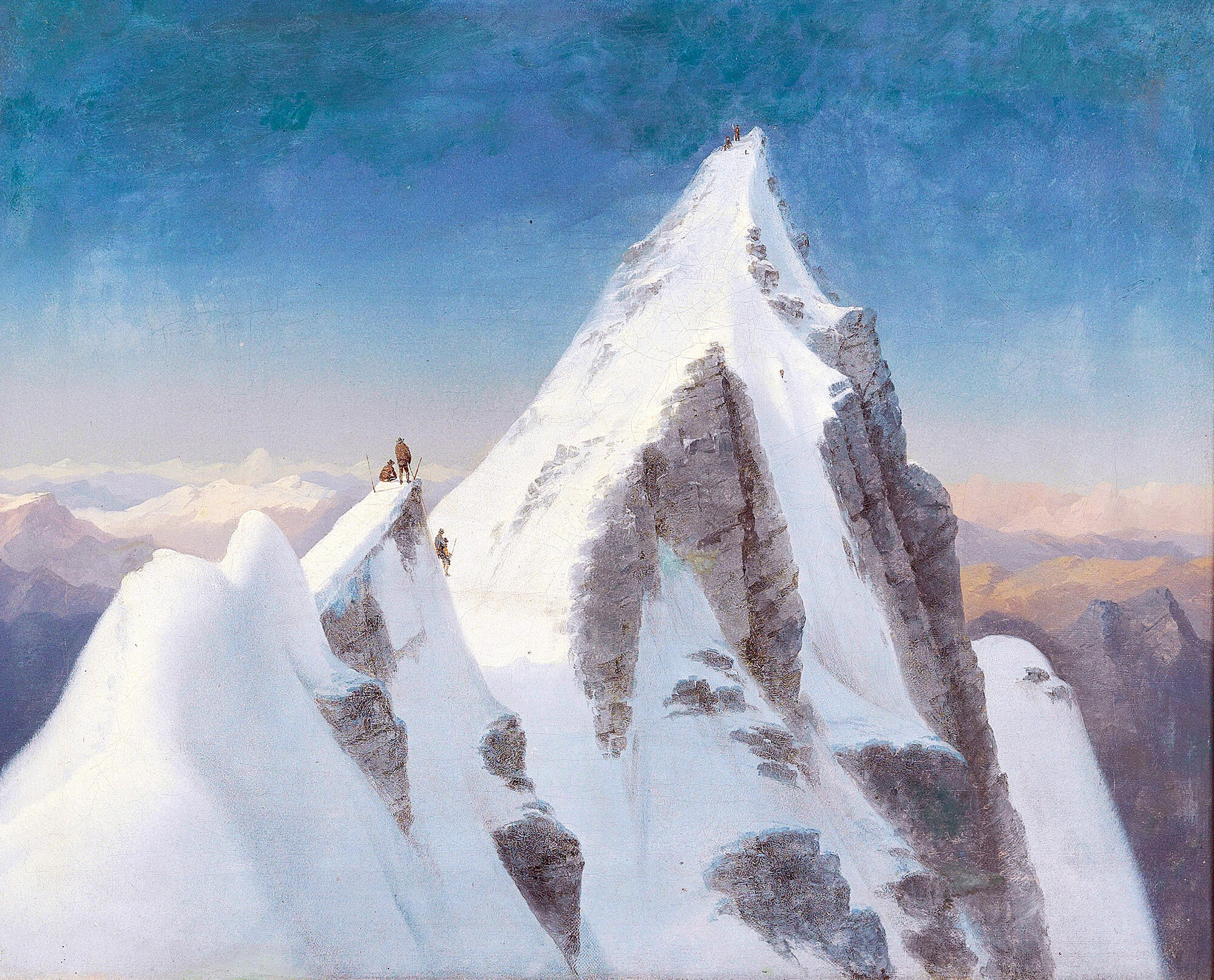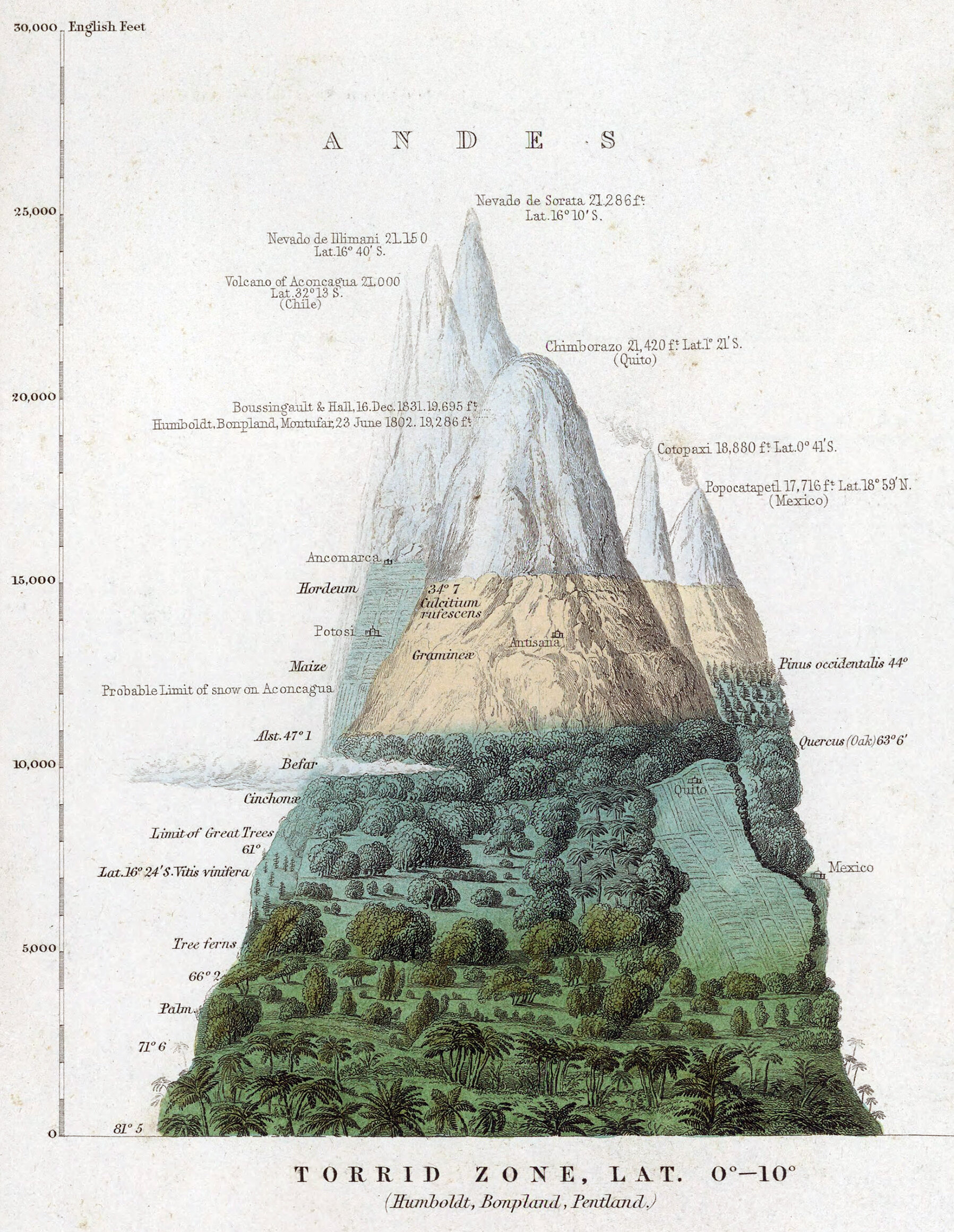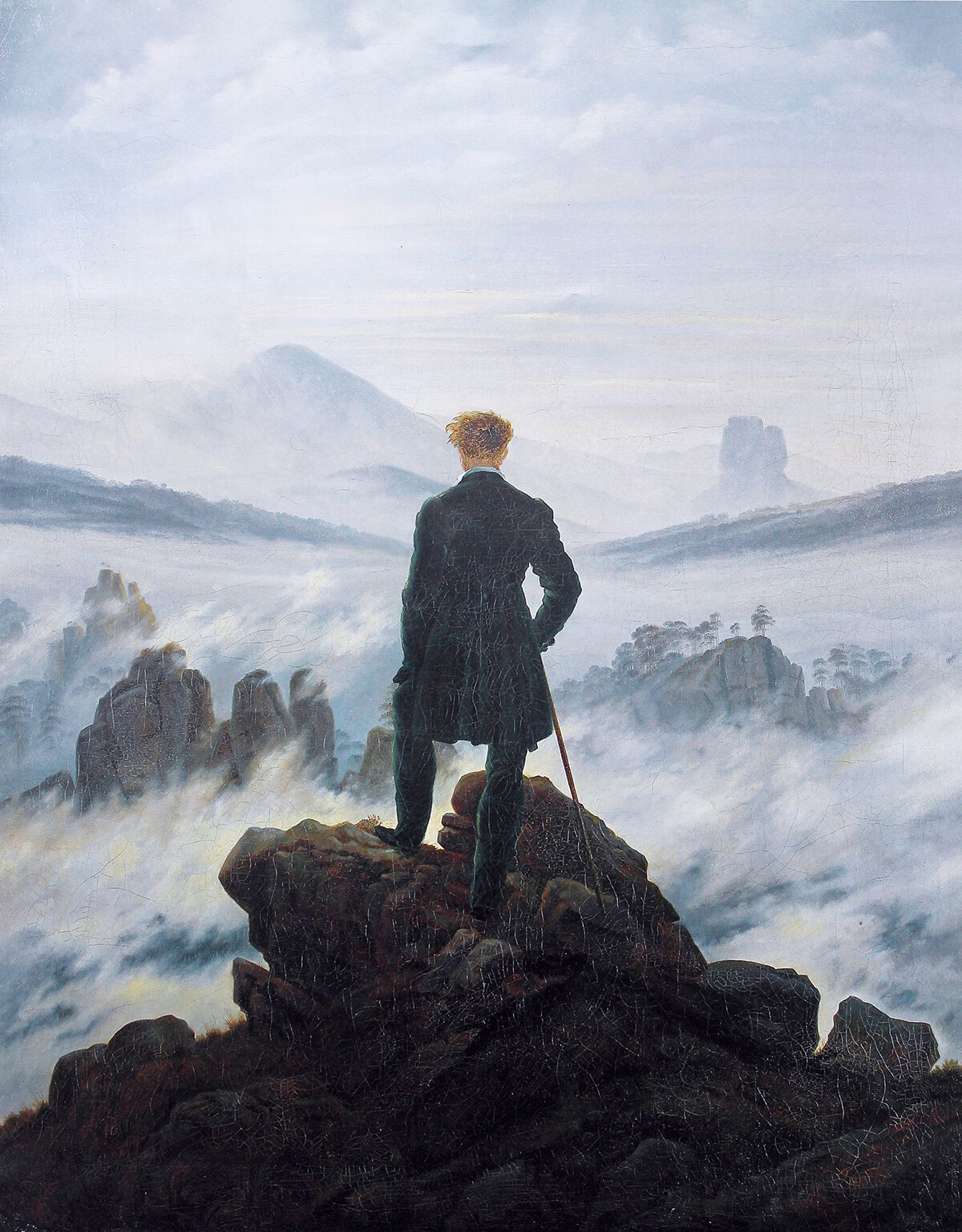Welcome to On Verticality. This blog explores the innate human need to escape the surface of the earth, and our struggles to do so throughout history. If you’re new here, a good place to start is the Theory of Verticality section or the Introduction to Verticality. If you want to receive updates on what’s new with the blog, you can use the Subscribe page to sign up. Thanks for visiting!
Click to filter posts by the three main subjects for the blog : Architecture, Flight and Mountains.
“During my thirty-three hours on the Eiger I seemed to have been in a dreamland; not a dreamland of rich enjoyment, but a much more beautiful land where burning desires were translated into deeds.”
-Jürgen Wellenkamp, German mountaineer, 1930-1956.
“Mountaineering offers an emotional experience which cannot otherwise be reached.”
-George Mallory, English Mountaineer, 1886-1924.

The Altitudinal Decrease in Vegetation
Pictured above is an illustration from the 1860s by Jean-Augustin Barral, titled Décroissement Altitudinal de la Végétation, which is French for The Altitudinal Decrease in Vegetation. It’s a beautiful work that attempts to categorize vegetation types by elevation, which is known as altitudinal zonation. Barral gets the overall concept correct, but we now know the details to be much more nuanced and complex than his drawing suggests.

The First Ascent of the Matterhorn
There are few mountains in the world as instantly recognizable as the Matterhorn. Located in the Swiss Alps, this majestic pyramid of gneiss straddles the border between Switzerland and Italy and looms over the Swiss mountain town of Zermatt. Due to its location and visibility, it is legendary within the history of mountaineering . In the 1860’s it was the focus of an international competition to be the first to reach its summit. This story, which includes the first successful summit of the mountain, is a tale of triumph and tragedy, and it serves as a cautionary tale for mountaineers to this day.
"On the summit, your soul becomes part of the mountain. It makes you feel alive."
-Nirmal “Nims” Purja, Nepalese mountaineer, born 1983.
“It is because [mountains] have so much to give and give it so lavishly to those who will wrestle with them that men love the mountains and go back to them again and again.”
-Sir Francis Younghusband, British explorer and mountaineer, 1863-1942.
“The highest of mountains is capable of severity, a severity so awful and so fatal that the wiser sort of men do well to think and tremble even on the threshold of their high endeavour.”
-George Mallory, English Mountaineer, 1886-1924.
"[Getting to the top of Everest is] a matter of universal human endeavor, a cause from which there is no withdrawl, whatever losses it may demand."
-Günter O. Dyhrenfurth, German mountaineer and geologist, 1886-1975.

Markus Pernhart’s Großglockner Paintings
The above painting was created in 1871 by Austrian artist Markus Pernhart. It shows the peak of the Großglockner, or Grossglockner, which is the tallest mountain in Austria. It does a great job capturing the contrasting scales of human and mountain. If you look closely, there are two groups of mountaineers pictured atop each peak, dwarfed by the jagged forms of snow and rock. This puts the focus of the painting on the majestic beauty of the mountaintop, rather than the effort it took the mountaineers to reach it. In many ways, these mountaineers are meaningless when compared to the mountain itself. The Großglockner has been around for millennia, and will still be around long after this expedition is finished.
“Is this the summit, crowning the day? How cool and quiet! We're not exultant; but delighted, joyful; soberly astonished.”
-George Mallory, English mountaineer, 1886-1924.

Anecdotes : Earning the Summit
I recently had the opportunity to summit Mount Washington in New Hampshire, and the experience brought to light a few aspects of verticality for me. It’s the tallest peak in the Northeast US, famous for it’s erratic weather patterns. As such, it’s been commercialized with a cog railway, auto road, visitor center and museum in order to attract tourist dollars to the park. This makes for an interesting summit experience, which is quite different than a typical mountaintop. Put simply, this is a summit you don’t have to earn by climbing up to it.
“What is the use of climbing Mount Everest? It is of no use. What we get from this adventure is just sheer joy. And joy is, after all, the end of life.”
-George Mallory, English mountaineer, 1886-1924.
“The mountains are calling, and I must go.”
-John Muir, Scottish naturalist and mountaineer, 1838-1914
“There is a kind of supernatural beauty in these mountainous prospects which charms both the senses and the minds into a forgetfulness of oneself and of everything in the world.”
-Jean-Jacques Rousseau, Genevan philosopher and writer, 1712-1778.

Altitudinal Zonation : Mountains and Verticality
The earth’s atmosphere is defined by vertical gradients. As one rises, the air thins out, humidity decreases, and temperatures drop. It’s why we get altitude sickness when we travel to high places, and it’s why the tops of very high mountains are snow-capped. These vertical gradients are defined by altitudinal zonation.
“[In the mountains], the highest parts of the loftiest peaks seem to be above the laws that rule our world below, as if they belonged to another sphere.”
-Conrad Gesner, Swiss physician and naturalist, 1516-1565.

Caspar David Friedrich’s Wanderer Above the Sea of Fog
Climbing to the top of a mountain is the closest a person can get to escaping the earth’s surface without taking flight. It’s a triumph over gravity, and it gives the climber a great sense of accomplishment as well as a command over the surrounding landscape. This painting encapsulates all of this beautifully. It was painted around 1818 by Caspar David Friedrich, and it’s called Wanderer Above the Sea and Fog.
“Every one must know the feeling of triumph and pride which a grand view from a height communicates to the mind”
-Charles Darwin, English biologist, 1809-1882.

Anecdotes : Mountain Climbing and Verticality
I took the above photo on a recent hike up Mount Washington in the White Mountains of New Hampshire. I was at the Lake of the Clouds, which is a small pond near the summit. The ascent up the mountain brought me face-to-face with some of the most breath-taking and unforgiving landscapes I’ve ever experienced. It was an intensely personal experience, and I still find myself struggling for the words to describe my feelings throughout the climb. It also helped me to understand a few aspects of the human need for verticality, and I’ll explore them in the following paragraphs.
“This is the human paradox of altitude: that it both exalts the individual mind and erases it. Those who travel to mountain tops are half in love with themselves, and half in love with oblivion.”
-Robert Macfarlane, British author, born 1976
